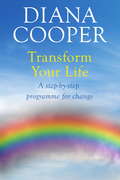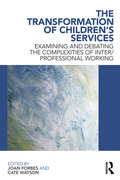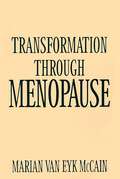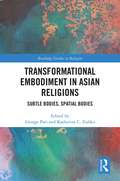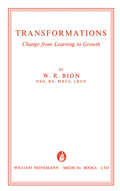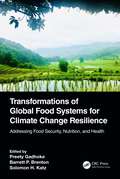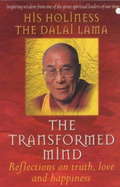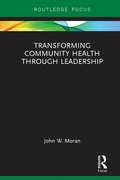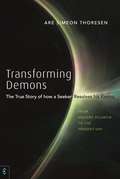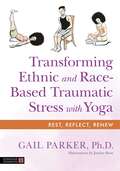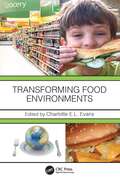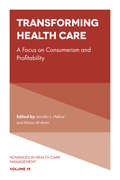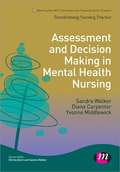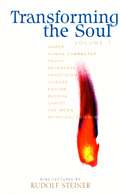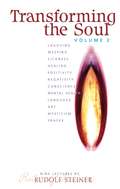- Table View
- List View
Transform Your Body With Weights: Complete Workout and Meal Plans From Beginner to Advanced
by Chloe MadeleyHave you ever wanted to add weights into your exercise routine but not known where to start? Or perhaps you already lift weights but want to know how to achieve a different aesthetic result? In Transform Your Body with Weights, Chloe Madeley tells you everything you need to know in order to weight-train correctly and effectively.She provides three different exercise and nutrition plans to choose from depending on whether you want to lose fat, gain muscle or increase your strength. Whether you are a beginner, intermediate or advanced, Chloe will guide you through the appropriate exercises for your level. With fully illustrated, day-by-day exercise instructions and a comprehensive food bible with recipes, everything you need to know to start your weight-lifting journey is in these pages.
Transform Your Life: A step-by-step programme for change
by Diana CooperDiana Cooper believes we can all transform our lives if we really want to. This inspiring book will help you to be who you want to be and do what you want to do. It will help you to bring hidden blockages to the surface, establish new positive belief patterns, and make your dreams come true.
The Transformation of Children's Services: Examining and debating the complexities of inter/professional working
by Joan Forbes Cate WatsonCan we imagine different ways of working together to secure better outcomes for children and families? What are the complex issues that underlie the apparently simple call for ‘joined-up’ services? Children’s services in many countries around the world are being transformed as part of the call for ‘joined-up working for joined-up solutions’. Social, health and educational policy discourses are driven by the idea that ‘effective’ inter/professional, interagency collaboration is crucial in determining whether service delivery to children and families will succeed or fail. However, the rapid turn from previous inter/professional practices of liaison, consultancy, cooperation and collaboration to more radical and wholescale service integration and sector transformation has not been accompanied either by a well considered research agenda of hard questions nor close scrutiny of its effects and consequences. The book asks a series of searching and challenging questions: What are the complex issues involved in children’s sector transformation for all those involved – young people, practitioners, leaders and managers, policy makers? How can the ‘silos’ in which professionals have traditionally been prepared for practice be broken down? What are the orthodoxies that surround ‘joined-up’ working and in what ways should they be challenged? Written by authors from across the wide range of professional, policy and disciplinary groups involved in this new cross-cutting area of policy and practice, this book provides a critical analysis of the complexities of children’s services transformations. The research in this collection addresses the range of discursive, policy and organizational developments associated with the transformation of children’s services, providing an important and timely analysis of their complexities and is essential reading for all those working in the complex spaces of children’s services.
The Transformation of Children's Services: Examining and debating the complexities of inter/professional working
by Joan Forbes Cate WatsonCan we imagine different ways of working together to secure better outcomes for children and families? What are the complex issues that underlie the apparently simple call for ‘joined-up’ services? Children’s services in many countries around the world are being transformed as part of the call for ‘joined-up working for joined-up solutions’. Social, health and educational policy discourses are driven by the idea that ‘effective’ inter/professional, interagency collaboration is crucial in determining whether service delivery to children and families will succeed or fail. However, the rapid turn from previous inter/professional practices of liaison, consultancy, cooperation and collaboration to more radical and wholescale service integration and sector transformation has not been accompanied either by a well considered research agenda of hard questions nor close scrutiny of its effects and consequences. The book asks a series of searching and challenging questions: What are the complex issues involved in children’s sector transformation for all those involved – young people, practitioners, leaders and managers, policy makers? How can the ‘silos’ in which professionals have traditionally been prepared for practice be broken down? What are the orthodoxies that surround ‘joined-up’ working and in what ways should they be challenged? Written by authors from across the wide range of professional, policy and disciplinary groups involved in this new cross-cutting area of policy and practice, this book provides a critical analysis of the complexities of children’s services transformations. The research in this collection addresses the range of discursive, policy and organizational developments associated with the transformation of children’s services, providing an important and timely analysis of their complexities and is essential reading for all those working in the complex spaces of children’s services.
Transformation Through Menopause
by Marian Van Mccain[This] is by far the most wise and thought provoking book on menopause that I have ever read. It is must reading for every woman who dares to meet the challenges of menopause fully and consciously. Christiane Northrup, M.D. This volume presents a holistic, theoretical framework for understanding menopause as a major developmental event in women's lives. Rather than an unpleasant phase to be endured or alleviated, Marian Van Eyk McCain views menopause as an empowering experience that women can use for personal growth. Artfully interweaving her research, years of clinical experience, and her personal perceptions of menopause to create an inspiring new vision of the change of life. She goes well beyond a discussion of hormones and hot flashes to uncover the deep emotional and spiritual significance of this time in women's lives.This book is not only about change on a personal or physical level but in society as well. McCain lays out historical and cross-cultural beliefs about menstruation and menopause and the attitudes surrounding them (from taboos to reverence) and points out that in our modern society women most often either try to ignore or make it through this essential period of womanhood in order to compete in a man's world on male terms. In tune with recent feminist thought, the author says there is a new womanpower emerging, which means that it is time for women to honor their natural cycles. There is no other book that combines the insights, inspiration, and wealth of information contained in this work. It is an important book for the alternative-minded baby-boom generation who are seeking new ways to approach middle age.
Transformational Embodiment in Asian Religions: Subtle Bodies, Spatial Bodies (Routledge Studies in Religion)
by George Pati Katherine ZubkoThis volume examines several theoretical concerns of embodiment in the context of Asian religious practice. Looking at both subtle and spatial bodies, it explores how both types of embodiment are engaged as sites for transformation, transaction and transgression. Collectively bridging ancient and modern conceptualizations of embodiment in religious practice, the book offers a complex mapping of how body is defined. It revisits more traditional, mystical religious systems, including Hindu Tantra and Yoga, Tibetan Buddhism, Bon, Chinese Daoism and Persian Sufism and distinctively juxtaposes these inquiries alongside analyses of racial, gendered, and colonized bodies. Such a multifaceted subject requires a diverse approach, and so perspectives from phenomenology and neuroscience as well as critical race theory and feminist theology are utilised to create more precise analytical tools for the scholarly engagement of embodied religious epistemologies. This a nuanced and interdisciplinary exploration of the myriad issues around bodies within religion. As such it will be a key resource for any scholar of Religious Studies, Asian Studies, Anthropology, Sociology, Philosophy, and Gender Studies.
Transformational Embodiment in Asian Religions: Subtle Bodies, Spatial Bodies (Routledge Studies in Religion)
by George Pati Katherine ZubkoThis volume examines several theoretical concerns of embodiment in the context of Asian religious practice. Looking at both subtle and spatial bodies, it explores how both types of embodiment are engaged as sites for transformation, transaction and transgression. Collectively bridging ancient and modern conceptualizations of embodiment in religious practice, the book offers a complex mapping of how body is defined. It revisits more traditional, mystical religious systems, including Hindu Tantra and Yoga, Tibetan Buddhism, Bon, Chinese Daoism and Persian Sufism and distinctively juxtaposes these inquiries alongside analyses of racial, gendered, and colonized bodies. Such a multifaceted subject requires a diverse approach, and so perspectives from phenomenology and neuroscience as well as critical race theory and feminist theology are utilised to create more precise analytical tools for the scholarly engagement of embodied religious epistemologies. This a nuanced and interdisciplinary exploration of the myriad issues around bodies within religion. As such it will be a key resource for any scholar of Religious Studies, Asian Studies, Anthropology, Sociology, Philosophy, and Gender Studies.
Transformations: Change from Learning to Growth
by W. R. BionTransformations: Change from Learning to Growth is a 12-chapter text that explores the fundamentals and principles of psycho-analytic theories, transformations, and invariants. This book begins with a clinical illustration of the distinction between the patient's experience and the psycho-analyst's experience. The succeeding chapters cover the influence of verbal expression, emotional experience, state of mind, and consciousness in psycho-analysis and transformation. These topics are followed by discussion on the relationship of the "no-thing and the thing, wherein the personality that is capable of tolerating a no-thing can make use of the no-thing, and so is able to make use of the so-called thoughts. The remaining chapters describe a clinical system that would represent the chief clinical systems that can be seen to exist in the analytic situation. These chapters also examine the gap between reality and the personality, which are aspects of life with which analysts are familiar under the guise of resistance. Resistance operates because it is feared that the reality of the object is imminent. This book will be of value to psycho-analysts, psychologists, and psychiatrists.
Transformations of Global Food Systems for Climate Change Resilience: Addressing Food Security, Nutrition, and Health
by Preety Gadhoke Barrett P. Brenton Solomon H. KatzTransformations of Global Food Systems for Climate Change Resilience: Addressing Food Security, Nutrition, and Health provides poignant case studies of climate change resilience frameworks for nutrition-focused transformations of agriculture and food systems, food security, food sovereignty, and population health of underserved and marginalized communities from across the globe. Each chapter is drawn from diverse cultural contexts and geographic areas, addressing local challenges of ongoing food and health system transformations and illustrating forms of resistance, resilience, and adaptations of food systems to climate change. Fourteen chapters present global case studies, which directly address the United Nations Sustainable Development Goals and the Food and Agriculture Organization’s global call to action for transforming agriculture, addressing food security and nutrition, and the health of populations impacted by climate change and public health issues.They also integrate reflections, insights, and experiences resulting from the COVID-19 Pandemic. This edited volume includes research on (1) enhancing food sovereignty and food security for underserved populations with a particular focus on indigenous peoples; (2) improving locally contextualized definitions and measurements of climate change resilience, food security, hunger, nutrition, and health; (3) informing public health programs and policies for population health and nutrition; and (4) facilitating public and policy discourse on sustainable futures for community health and nutrition in the face of climate change and natural disasters, including ongoing and future pandemics or emergencies. Within this book, readers discover an array of approaches by the authors that exemplify the mutually engaged and reciprocal partnerships that are community-driven and support the positive transformation of the people with whom they work. By doing so, this book informs and drives a global sustainable future of scholarship and policy that is tied to the intersectionality and synergisms of climate change resilience, food security, food sovereignty, nutrition, and community health.
Transformations of Global Food Systems for Climate Change Resilience: Addressing Food Security, Nutrition, and Health
Transformations of Global Food Systems for Climate Change Resilience: Addressing Food Security, Nutrition, and Health provides poignant case studies of climate change resilience frameworks for nutrition-focused transformations of agriculture and food systems, food security, food sovereignty, and population health of underserved and marginalized communities from across the globe. Each chapter is drawn from diverse cultural contexts and geographic areas, addressing local challenges of ongoing food and health system transformations and illustrating forms of resistance, resilience, and adaptations of food systems to climate change. Fourteen chapters present global case studies, which directly address the United Nations Sustainable Development Goals and the Food and Agriculture Organization’s global call to action for transforming agriculture, addressing food security and nutrition, and the health of populations impacted by climate change and public health issues.They also integrate reflections, insights, and experiences resulting from the COVID-19 Pandemic. This edited volume includes research on (1) enhancing food sovereignty and food security for underserved populations with a particular focus on indigenous peoples; (2) improving locally contextualized definitions and measurements of climate change resilience, food security, hunger, nutrition, and health; (3) informing public health programs and policies for population health and nutrition; and (4) facilitating public and policy discourse on sustainable futures for community health and nutrition in the face of climate change and natural disasters, including ongoing and future pandemics or emergencies. Within this book, readers discover an array of approaches by the authors that exemplify the mutually engaged and reciprocal partnerships that are community-driven and support the positive transformation of the people with whom they work. By doing so, this book informs and drives a global sustainable future of scholarship and policy that is tied to the intersectionality and synergisms of climate change resilience, food security, food sovereignty, nutrition, and community health.
Transformative Imagery: Cultivating the Imagination for Healing, Change, and Growth
by Rachel Naomi Remen Judith Lyons Llewellyn Vaughan-Lee Linda Graham Ruth L. Schwartz David Pincus Charlotte Reznick Glenn Hartelius Martin L. Rossman Laury Rappaport Denise Grocke Zhongxian Wu Aftab Omer Alan Morinis Emmett Miller Michael F. Cantwell Carolyn J. Bohler Michael Samuels Bruce Roberts Dean Shrock Gerald Epstein Sondra Barrett Anees A. Sheikh Judith Goleman Phillip Post Brian DietrichTransformative Imagery brings together the voices of instrumental figures in guided imagery to provide professionals with an extensive, detailed overview of the proven transformational potential of imagery. Key chapters demonstrate how this can be integrated with conventional medicine to benefit patients and clients in any setting.
The Transformed Mind: Reflections On Truth, Love, And Happiness (Essential Teachings Of The Buddha Ser.)
by Dalai Lama The Dalai LamaIn his characteristically endearing and informal style, His Holiness the Dalai Lama examines the nature of the human mind and emphasises the need to transform it if we want to lead more fulfilling lives. In the form of several discourses delivered over a period of nine years, he talks about suffering, happiness, love and truth, and imparts practical wisdom on issues ranging from religious tolerance to world economy. Stressing the need for compassion and non-violence, the Dalai Lama reiterates the essential goodness of the human heart and teaches us how to live and die well, reminding us constantly of the responsibility of our actions and thoughts, and the interdependence between action and result. Wise, inspiring and always candid, The Transformed Mind gives us hope and solace in this new millennium.
Transforming Community Health through Leadership
by John W. MoranAs the United States faces increasingly difficult and trenchant public health problems, from the Zika virus to the obesity epidemic to the opioid crisis, population health is a growing area of concern for public health organizations, particularly how to care for populations effectively on a shoestring budget. Though little discussed in the mainstream media, community health improvement organizations are increasingly partnering and forming coalitions with local hospitals, working together to improve traditional medical care. But with the pace of change in health care policy, these coalitions must be thoughtfully lead and managed. This new book from John W. Moran, Senior Quality Advisor to the Public Health Foundation, demonstrates how to build, operate, manage, and sustain a community health improvement coalition once it is formed. Offering the reader practical examples and guidance on forming and sustaining a community health coalition, this book demonstrates the ways in which the success of a coalition depends upon a stable anchor organization and a committed leader. Chapters focus on each of these roles and how to achieve success in each: examining what needs improvement, why it is important to improve now, how it will be done, and where in the community improvement can have the most impact. The last chapter offers a case study exploring a community health coalition and leader to illustrate application of the concepts introduced throughout the book. Transforming Community Health through Leadership is designed specifically to prepare governmental public health, health care, and community leaders to take advantage of the ever-changing landscape of public health and health care in concrete ways to improve population health.
Transforming Community Health through Leadership
by John W. MoranAs the United States faces increasingly difficult and trenchant public health problems, from the Zika virus to the obesity epidemic to the opioid crisis, population health is a growing area of concern for public health organizations, particularly how to care for populations effectively on a shoestring budget. Though little discussed in the mainstream media, community health improvement organizations are increasingly partnering and forming coalitions with local hospitals, working together to improve traditional medical care. But with the pace of change in health care policy, these coalitions must be thoughtfully lead and managed. This new book from John W. Moran, Senior Quality Advisor to the Public Health Foundation, demonstrates how to build, operate, manage, and sustain a community health improvement coalition once it is formed. Offering the reader practical examples and guidance on forming and sustaining a community health coalition, this book demonstrates the ways in which the success of a coalition depends upon a stable anchor organization and a committed leader. Chapters focus on each of these roles and how to achieve success in each: examining what needs improvement, why it is important to improve now, how it will be done, and where in the community improvement can have the most impact. The last chapter offers a case study exploring a community health coalition and leader to illustrate application of the concepts introduced throughout the book. Transforming Community Health through Leadership is designed specifically to prepare governmental public health, health care, and community leaders to take advantage of the ever-changing landscape of public health and health care in concrete ways to improve population health.
Transforming Demons: The True Story of how a Seeker Resolves his Karma: From Ancient Atlantis to the Present-day
by Are ThoresenHaving misused women, power and the life-energy of his followers, the Seeker must overcome his demons – not figuratively but literally – in the astral, etheric and physical dimensions of reality. But in order to face them, he must first cross the threshold to the spiritual world…Transforming Demons takes us on an astonishing journey – from contemporary Norway to Ancient Atlantis, to Ireland and India – where we encounter leprechauns, dragons, evil spirits, hallucinogenic drugs, and a mysterious golden cross with a red ruby at its heart.With hubris, arrogance and deceit, the Seeker has abused his magical powers in previous existences. If he is finally to resolve his knotted karma, he must first confront his misdeeds, and the demons that were created as a result. Then he must learn to transform those demons in order to free them – and him – from the weight of his past.This is a remarkable true memoir that crosses lifetimes, thousands of years and manifold dimensions. It is an authentic story of transformation and redemption on the path to self-knowledge, freedom and love.
Transforming Ethnic and Race-Based Traumatic Stress with Yoga
by Gail ParkerBuilding on the foundations of Restorative Yoga for Ethnic and Race-Based Stress and Trauma by Gail Parker, this workbook offers a range of self-care practices that strengthen the psychological immune system, increase resilience, and support post-traumatic growth.Ethnic and race-based traumatic stress is a worldwide phenomenon. Regardless of race and ethnicity we are all impacted by its damaging effects, from those who are wounded to those who do the wounding. We are witnessing health care disparities based on race and ethnicity that are causing great suffering, and also witnessing a global awakening to the pandemic of racial violence and its pernicious effects on all of us.Transforming Ethnic and Race-Based Traumatic Stress with Yoga is a self-care study guide where each chapter includes a reading for contemplation on an area of ethnic and/or race related traumatic stress, an illustration of a Restorative Yoga pose with instructions on how to get into it and accompanied by positive affirmations to repeat while in the pose. This is followed by a therapeutic journal writing instruction with blank pages for journal entries to reinforce the affirmations and to identify the psychological, mental, emotional, and spiritual benefits of the posture presented.
Transforming Food Environments
by Charlotte E.L. EvansWe regularly find ourselves in food environments that promote the consumption of high fat and sugary foods rather than encouraging us to eat more fruit and vegetables. However, because of increased media attention, people are becoming more interested in alternative approaches to improving the many food-related decisions we make daily. Transforming Food Environments features evidence from several disciplines exploring initiatives that have improved food environments and discusses the importance of achieving success in equitable and sustainable ways. The book presents information on diverse food environments followed by methods that help readers become aware of the design of interventions and food policies. It covers food environments in schools, workplaces, and community centres as well as fast food establishments and food marketing. The book presents methods to help encourage better food choices and purchase of healthier foods. It explores persuasion tactics used by health professionals such as changing availability and/or price, using nudging techniques, and food labelling. Led by Editor Charlotte Evans, Associate Professor of Nutritional Epidemiology and Public Health Nutrition at the University of Leeds; and written by an international range of authors from countries including the US, Canada, Australia, New Zealand, Japan and the United Kingdom, this multidisciplinary book appeals to students, researchers, public health professionals and policy makers. It also raises awareness and provides a comprehensive treatment of the importance of our environments on food choice.
Transforming Food Environments
by Charlotte El EvansWe regularly find ourselves in food environments that promote the consumption of high fat and sugary foods rather than encouraging us to eat more fruit and vegetables. However, because of increased media attention, people are becoming more interested in alternative approaches to improving the many food-related decisions we make daily. Transforming Food Environments features evidence from several disciplines exploring initiatives that have improved food environments and discusses the importance of achieving success in equitable and sustainable ways. The book presents information on diverse food environments followed by methods that help readers become aware of the design of interventions and food policies. It covers food environments in schools, workplaces, and community centres as well as fast food establishments and food marketing. The book presents methods to help encourage better food choices and purchase of healthier foods. It explores persuasion tactics used by health professionals such as changing availability and/or price, using nudging techniques, and food labelling. Led by Editor Charlotte Evans, Associate Professor of Nutritional Epidemiology and Public Health Nutrition at the University of Leeds; and written by an international range of authors from countries including the US, Canada, Australia, New Zealand, Japan and the United Kingdom, this multidisciplinary book appeals to students, researchers, public health professionals and policy makers. It also raises awareness and provides a comprehensive treatment of the importance of our environments on food choice.
Transforming Healthcare: A focus on Consumerism and Profitability (Advances in Health Care Management #19)
by Jennifer L. Hefner Mona Al-AminShedding light on current transformations in payment mechanisms and transparency of hospital performance data and prices, this volume of Advances in Health Care Management presents findings on hospital profitability, cost, and organizational structures. Divided into two sections: 'Reimbursement, Cost and Profitability' and 'The Move Towards Transparency', the chapters employ a variety of research methodologies to explore the impact of transformation in payment and debt structures, profitability, and horizontal or vertical integration on outcomes such as price, clinical outcomes, and health plan selection. The authors examine recent changes including the redesign of the U.S. health care system to achieve higher value, and the establishment of mechanisms that transform reimbursement models and promote consumerism through transparency of data. Additionally, the volume takes a look at the emerging trend of transparency between health care stakeholders such as patients, health care staff, hospitals, insurance companies, and the government, providing a valuable insight into how the future might look.
Transforming Healthcare: A focus on Consumerism and Profitability (Advances in Health Care Management #19)
by Jennifer L. Hefner, Mona Al-AminShedding light on current transformations in payment mechanisms and transparency of hospital performance data and prices, this volume of Advances in Health Care Management presents findings on hospital profitability, cost, and organizational structures. Divided into two sections: 'Reimbursement, Cost and Profitability' and 'The Move Towards Transparency', the chapters employ a variety of research methodologies to explore the impact of transformation in payment and debt structures, profitability, and horizontal or vertical integration on outcomes such as price, clinical outcomes, and health plan selection. The authors examine recent changes including the redesign of the U.S. health care system to achieve higher value, and the establishment of mechanisms that transform reimbursement models and promote consumerism through transparency of data. Additionally, the volume takes a look at the emerging trend of transparency between health care stakeholders such as patients, health care staff, hospitals, insurance companies, and the government, providing a valuable insight into how the future might look.
Transforming Nursing Practice: Assessment and Decision Making in Mental Health Nursing (PDF)
by Sandra WalkerAssessment is an essential part of mental-health nursing and as such a core learning requirement for pre-registration nursing students. Getting assessment right is essential for the nursing student in order for them to become an effective practitioner. Many books on assessment are very theoretical. This is a practical, hands-on guide to the assessment process, underpinned by the latest evidence. The book explains the core principles through running case studies, so that readers can see how each decision they make impacts on the person in their care. Key features: Assessment principles are applied across a variety of modern nursing settings that you may find yourself working in as a registered nurse Each chapter is linked to the relevant NMC standards and Essential Skills Clusters so you know you are meeting the professional requirements Activities throughout help you to think critically and develop essential graduate skills.
Transforming The Soul: Volume 1
by Rudolf SteinerThe spiritual-scientific investigator has ... to transform the soul itself into an instrument; then - when his soul is awakened and he can see into a spiritual world - he experiences, on a higher level, a similar great moment as blind people do when, having been operated upon, they look at a world they have not seen before. In a key series of lectures on personal development, Rudolf Steiner explains that the central mission of spiritual science is to enable people to ascend, in full consciousness, to a knowledge of spiritual realities. But given that the means to achieve spiritual perception are now widely available, the danger exists that some individuals will gain access to the spiritual world whilst harbouring impure motives. This can lead to a distorted understanding and vision of that world. Steiner's emphasis, therefore, is on the preparatory steps - the metamorphosis and purification of the human soul - required for achieving true spiritual enlightenment. Life itself teaches and prepares us for progress, and anthroposophy explains and brings this to consciousness. In some of his most lucid lectures, Steiner describes the missions of anger, truth and reverence, the significance of human character, the meaning of asceticism and illness, and the phenomenon of egoism. He also clarifies the differences between Buddhism and Christianity, describes the goal of spiritual science, and makes some esoteric observations about the moon. Throughout the talks Steiner refers to many significant historical figures, including St Augustine, Coleridge, Leonardo da Vinci, Madame Blavatsky, Goethe, Homer, and Shakespeare.
Transforming The Soul: Volume 2
by Rudolf SteinerThose who observe human nature with regard to the smallest things will find that everyday experiences can also lead to an understanding of the greatest actualities...' In a refreshingly practical series of lectures, Rudolf Steiner speaks about the nature of the human soul and how it can be metamorphosed and raised to a higher consciousness. He studies the spiritual significance of various expressions of human nature, including laughing and weeping, sickness and health, error and mental disorder, positivity and negativity, and conscience. Steiner also discusses the nature of prayer, mysticism, the mission of art, and the significance of language. Throughout the talks he refers to many key historical figures, including Zarathustra, Socrates, Plato, Homer, Wagner, Goethe, Hegel and Angelus Silesius. These inspiring lectures form the conclusion to Transforming the Soul, Volume 1, but can also be read independently.
Transforming the Doctor's Office: Principles from Evidence-based Design
by Ann Sloan DevlinFrom the parking lot to the exam room, doctors can improve the physical surroundings for their patients, yet often they do not. Given the numerous and varied duties doctors must perform, it may fall to the design profession to implement changes, many based on research, to improve healthcare experiences. From location and layout to furnishings and positive distractions, this book provides evidence-based information about the physical environment to help doctors and those who design medical workspaces improve the experience of health care. Along with its research base, a special aspect of this book is the integration of relevant historical material about the office practice of physicians at the beginning of the twentieth century. Many of their design solutions are viable today. In addition to improving the physical design of healthcare facilities, author Ann Sloan Devlin is the granddaughter, daughter, and niece of physicians, as well as the granddaughter and daughter of nurses. She worked in a hospital during college, and has visited a good many practitioners’ offices in medical office buildings and ambulatory care settings. This book addresses an overlooked location of care: the doctor’s office suite.
Transforming the Doctor's Office: Principles from Evidence-based Design
by Ann Sloan DevlinFrom the parking lot to the exam room, doctors can improve the physical surroundings for their patients, yet often they do not. Given the numerous and varied duties doctors must perform, it may fall to the design profession to implement changes, many based on research, to improve healthcare experiences. From location and layout to furnishings and positive distractions, this book provides evidence-based information about the physical environment to help doctors and those who design medical workspaces improve the experience of health care. Along with its research base, a special aspect of this book is the integration of relevant historical material about the office practice of physicians at the beginning of the twentieth century. Many of their design solutions are viable today. In addition to improving the physical design of healthcare facilities, author Ann Sloan Devlin is the granddaughter, daughter, and niece of physicians, as well as the granddaughter and daughter of nurses. She worked in a hospital during college, and has visited a good many practitioners’ offices in medical office buildings and ambulatory care settings. This book addresses an overlooked location of care: the doctor’s office suite.

